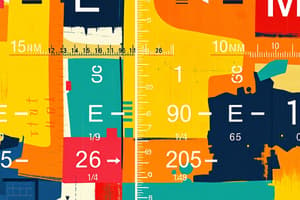Podcast
Questions and Answers
What does kilo (k) equal?
What does kilo (k) equal?
1,000
What does centi (c) equal?
What does centi (c) equal?
0.01
What does milli (m) equal?
What does milli (m) equal?
0.001
What does micro (mc) equal?
What does micro (mc) equal?
What does hecto (h) equal?
What does hecto (h) equal?
What does deka (da) equal?
What does deka (da) equal?
What does deci (d) equal?
What does deci (d) equal?
1 tablespoon (Tbsp) = ? mL
1 tablespoon (Tbsp) = ? mL
1 teaspoon (tsp) = ? mL
1 teaspoon (tsp) = ? mL
1 ounce (oz) = ? mL
1 ounce (oz) = ? mL
1 glass or 1 cup = ? mL
1 glass or 1 cup = ? mL
1 kilogram (kg) = ? pounds (lb)
1 kilogram (kg) = ? pounds (lb)
1 inch = ? cm
1 inch = ? cm
What must the nurse do if the amount of drug ordered by a physician is not within the recommended dosage range?
What must the nurse do if the amount of drug ordered by a physician is not within the recommended dosage range?
Which of the following are correct about recommended doses in drug references? Select all that apply.
Which of the following are correct about recommended doses in drug references? Select all that apply.
The nurse must convert everything into milliliters (mL) when calculating intake.
The nurse must convert everything into milliliters (mL) when calculating intake.
What is classified as output?
What is classified as output?
How do you calculate actual urine output?
How do you calculate actual urine output?
Flashcards are hidden until you start studying
Study Notes
Metric Prefixes
- Kilo (k) represents 1,000.
- Centi (c) represents 0.01.
- Milli (m) represents 0.001.
- Micro (mc) represents 0.000001 (5 zeros between decimal and 1).
- Hecto (h) represents 100.
- Deka (da) represents 10.
- Deci (d) represents 0.1.
Standard Rules for Writing Metric Numbers
- Use Arabic numbers with metric symbols (e.g., 1 mg, not I mg).
- Always include a space between numbers and metric symbols (e.g., 1 g).
- Place the Arabic number before the metric symbol (e.g., 1 g).
- Use decimal fractions instead of fractional units (e.g., 0.5 mg).
- Always include a leading zero before a decimal (e.g., 0.5 mL).
- Omit trailing zeros (e.g., 1 mL, not 1.0 mL).
- Use singular form for symbols (e.g., 15 mL, not 15 mLs).
- For large numbers use properly spaced commas (e.g., 5,000 units).
Household Measurements
- 1 tablespoon (Tbsp) equals 15 mL.
- 1 teaspoon (tsp) equals 5 mL.
- 1 ounce (oz) equals 30 mL.
- 1 drop (gtt) has no fixed equivalent and varies by pharmacy.
- 1 glass or 1 cup equals either 180 mL (6 oz) or 240 mL (8 oz).
- 1 kilogram (kg) equals 2.2 pounds (lb).
- 1 inch equals 2.54 cm.
Intake and Output Calculations
- For ice chips, divide the original volume in half for calculating intake.
- Intake includes any liquid food like water, ice cream, and coffee, converted into milliliters (mL).
- Continuous feeding intake: multiply hourly rate (mL/hr) by the number of hours infused.
- Intermittent feeding intake: sum the total amounts given during shifts.
- Output includes urine, emesis, gastric drainage, wound drainage, and diarrhea.
- Urinary catheters and wound drains are measured at the end of shifts.
Dosing Terminology
- Single Dose: medication administered at one time.
- Total Daily Dose: amount of medication given in 24 hours.
- Divided Dose: medication given in fractional portions at intervals.
- Initial Dose: first dose given to a patient.
- Loading Dose: initial large dose to quickly reach therapeutic levels.
- Maintenance Dose: dose required to sustain therapeutic effect.
- Dosage Range: the minimum and maximum safe and effective dose.
Safe Medication Practices
- Confirm unclear doses out of recommended ranges with the physician.
- Recommended doses can be single doses, dosage ranges, weight-based, or based on body surface area.
- Weight-based dosing adjusts medication according to the individual's weight (e.g., 1 mg/kg).
- If prescribed doses exceed the recommended range, clarification is necessary.
Weight-Based Dosing Examples
- For a patient weighing 50 kg, the dose of Medication A is calculated to be safe at 125 mcg/day while the order is for 150 mcg/day.
- For a patient weighing 110 lb, the order of 4.5 mcg of Medication B is safe when the calculated weight-based dose is 5 mcg bid.
- Dosages for various medications are adjusted based on both patient weight and specific drug guidelines.
The notes capture essential information about measurement conversions, dosing principles, and safe practices in medication administration critical for pharmacology and nursing studies.
Studying That Suits You
Use AI to generate personalized quizzes and flashcards to suit your learning preferences.




